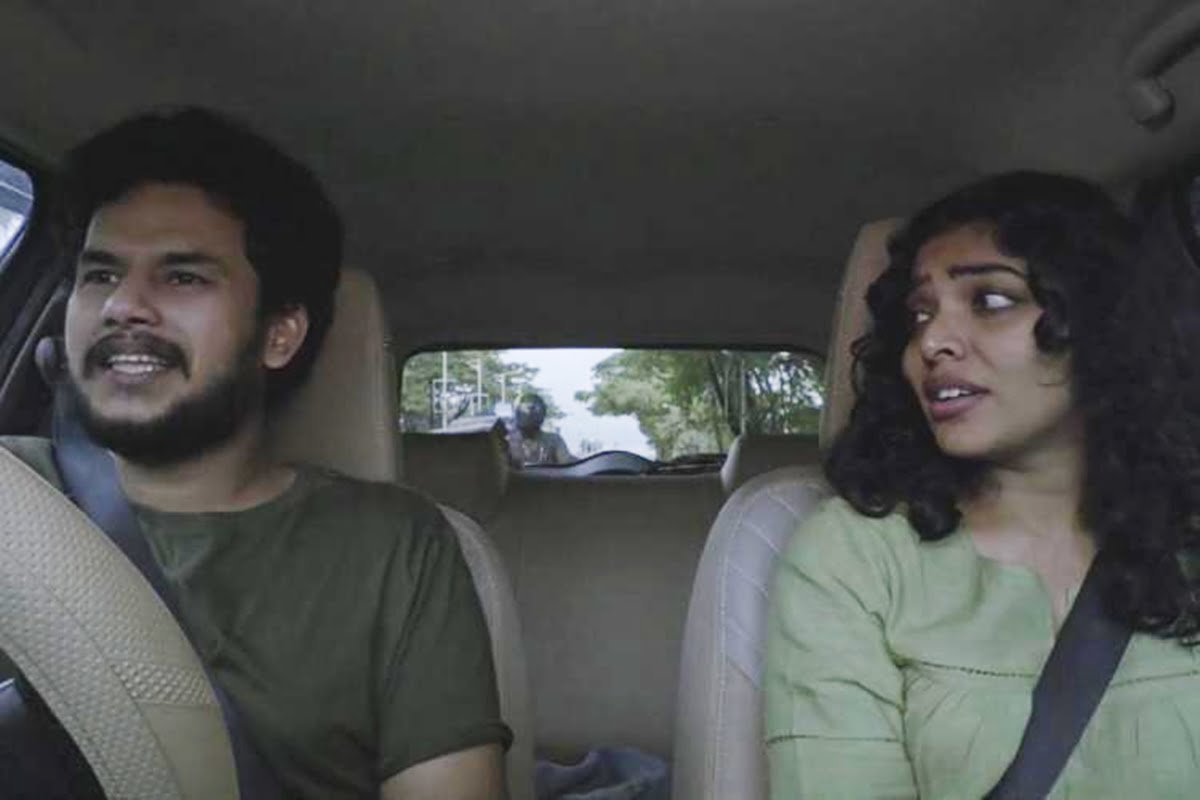“In my opinion, a woman has absolute autonomy over any decision concerning her body”, says the seemingly progressive protagonist of Santhoshathinte Onnam Rahasyam (The Joyful Mystery). Except, during the discussion, the female protagonist had mentioned and the man had agreed, that it was his idea to remove the condom for “better intimacy”.
Directed by Don Palathara, with central characters played by Rima Kallingal and Jitin Puthanchery, this one-shot movie is set in a moving car, as both of their characters travel to get the female protagonist, Maria‘s pregnancy test done.
Directed by Don Palathara, with central characters played by Rima Kallingal and Jitin PuthAnchery, Santhoshathinte Onnam Rahasyam is set in a moving car, as both of their characters travel to get the female protagonist, Maria‘s pregnancy test done.
Wilful neglect is abuse
At the beginning of Santhoshathinte Onnam Rahasyam, while Maria struggles through excruciating pain and nausea; her partner, Jitin, can be seen chuckling while looking at his phone. Unlike the usual movies where the ordeals of the woman is demonstrated for a few seconds as a phenomenon and not a pain; only to be followed by the wails of a newborn child, the movie does not trivialise her agony; it focuses and stresses on it. And that is followed up by her asking for accountability from Jitin.
Maria vehemently vocalises how the pregnancy is going to impact her body and that she will have to face multitudinous challenges. She explicates the social stigma her family would have to face in a patriarchal society given the couple were not married and were in a live-in relationship; a relationship that their family members were unaware of.
It can be ascertained how the male protagonist in Santhoshathinte Onnam Rahasyam appears to not be as empathetic as required, and gaslights Maria, and even when she is in immense mental and physical trauma herself, she has to do the emotional and intellectual labor of explaining fundamentals to him, further exacerbating her agony.
The impact is on the woman
One aspect touched upon in Santhoshathinte Onnam Rahasyam is that if Maria gets pregnant, it is only she who gets pregnant, and thus, the stakes are incomparably higher for her body, career and life. Hence, the agency and autonomy lie with her. However, another facet is that even if it is she who gets pregnant, the responsibility of dealing with its consequences and bringing up the offspring is something that solely the woman cannot be burdened with. In the context of women being completely independent, men cannot step back from taking equal responsibility of the repercussions of life-altering decisions.
Missing out on the paramount point
One of the most salient conversations that Santhoshathinte Onnam Rahasyam ought to have had was on contraception. Because as much as the movie holds the idea of critically analysing parenting as well as the choice of abortion and live-in relationships, what it does not discuss in detail is that the reason why the couple was in such a challenging phase, and the woman was undergoing trauma and stress, was because the man had refused to wear a condom stating the argument of “better intimacy”.
This global male tendency to not take the responsibility of contraception and to wrongly thrust it onto women, knowing well that the female contraceptive measures which have been devised are pernicious towards women and have umpteen side effects, is wrong. In the case of men, the contraception methods are easier and safe for men. Unless and until this topic is discussed in detail, the discourse remains incomplete. And hence, Santhoshathinte Onnam Rahasyam, though beautiful, is lacking, and in fact distasteful, given it is the negligence and selfishness of the man that had put both of them in such a perilous position; and this ought to be given time and focus during the discussion.
Characterisation of the woman
In the so-called mainstream movies about feminism, the woman is portrayed as a flawless woman — someone bereft of drawbacks. By extending this ‘superhuman’ characterisation, the male gaze of the movies then tends to ‘justify’ that since the woman is ‘perfect’, she deserves justice.
However, in the case of Santhoshathinte Onnam Rahasyam, the woman is shown as exasperating during the conversation — an extension of the situation she has been put into due to the egocentric nature of the man who did not take protection. What the movie shifts focus on to is that a woman need not be perfect in order to be deserving. The movie does have a problematic moment where at one point Maria even gets violent towards Jitin during the conversation, which in turn leads to a violent response from the latter. And throughout the journey, her arguments might be making driving a challenge for him.
Against the romanticisation of marriage and parenthood
When it comes to the topic of parenting, which is usually followed by a full-fledged celebratory song and dance sequence or depicted solely as “good news” and glorified as the “ultimate aim” of every woman, Santhoshathinte Onnam Rahasyam makes space for the conversations to take up the entirety of the couple’s dialogue, like every thinking couple would in today’s time.
The discussion takes a stand against the romanticisation of parenthood as well as marriage. It might be a bare minimum in an ideal world, but then, the one we live in isn’t one. Neither are the protagonists of the film who constantly engage in verbal combats.
The woman and her stand
Unlike the movies with pre-defined notions where the woman is shown as bound to be happy after getting the hint that she is pregnant, here the her life does not revolve around the ambition of parenting. Maria states how she was planning to apply for a Ph.D. abroad after her Master’s and had myriad plans, to which Jitin retaliates with how she could still pursue them. Maria then goes on to say that she doesn’t want to get married at all. The arguments keep on increasing and at one point, Jitin, who has been dilly-dallying all along blames her for everything and tells her to do what every woman has been doing.
Confined intimacy and constant fights
Taking a trial of each other’s patience, all throughout the journey, the couple in Santhoshathinte Onnam Rahasyam continues to argue in the closed space that they have been put into. Shot against the backdrop of the pandemic; a phase where most partners were forced to stay in confined spaces with each other, with no escape from raging emotions; finding themselves confronting past incidents which they might not have spoken about otherwise, the movie depicts people as more real and vulnerable. The altercations continue from both sides. And unlike the trope of the happily ever after, the movie continues to focus on the imperfections that ‘happily ever afters’ nicely skip: each of Maria’s and Jitin’s insecurities and gaslighting behaviour, even while in a stable relationship.
It further exposes how the ‘wokest’ of men display their traits of misogyny when a crisis such as this comes up.
Shot through a dashboard camera, five complete takes of the movie were obtained before finalisation. Despite not having a zoom-in, zoom-out, pan, or a shift in the angle; Santhoshathinte Onnam Rahasyam manages to enthrall us throughout the eighty minute duration, as the city changes subtle landscapes visible through the rear windshield and car windows. Similar to how things outside change amidst the pandemic, while lovers stay inside — together.
Santhoshathinte Onnam Rahasyam manages to enthrall us throughout the eighty minute duration, as the city changes subtle landscapes visible through the rear windshield and car windows. Similar to how things outside change amidst the pandemic, while lovers stay inside — together.
Subtlety creating space for profundity
Santhoshathinte Onnam Rahasyam says the most insightful things in the most unpretentious language. The camera displays the emotions deftly, and the color palette encompassing the mask, clothes, watch, bag as well as the car seat, is subtle and coordinated for escalated effect.
The characters in the movie do not carry the burden of being correct at all times. The movie depicts how with time, all relationships get a bit mundane, where there comes a sense of familiarity with a sense of lull. And the spirit of surprise goes away, though taking with it, certain amounts of anxiety and consequently unravelling raw emotions.
Also read: Film Review: Sara’s — A Refreshing Take On The Deification Of Motherhood
Calling out problematic takes
While the bare minimum tenets of gender equality have been hitherto erroneously and unjustifiably celebrated as “feminism” in ‘cinema’, Santhoshathinte Onnam Rahasyam calls such problematic takes out. Especially during a phone call in which Maria interviews a male director who is claiming to be making feminist movies when his comprehension of feminism is flawed in its essence.
Even though the movie does have an effervescent ending where the tiniest act of intimacy brings a smile, the conversation misses out on imperative tenets. Yet, in umpteen ways, Santhoshathinte Onnam Rahasyamdoes make way for myriad more beginnings.
About the author(s)
Ankita Apurva was born with a pen and a sickle.






beautiful trailer …
Kerala taxi Kochi airport taxi